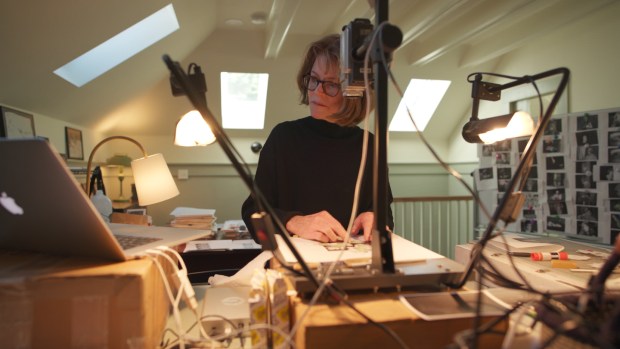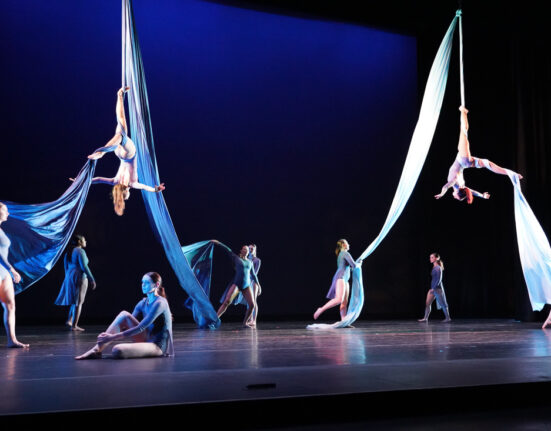Over the past decade, I have written about all five of the Colorado artists featured in a new documentary, “Time and Other Materials,” trying mightily to use my words to convey the essence of their work, and to put it in the context of the times we live in.
But this surprising film takes the opposite approach: It lets the subjects speak for themselves. They just talk about their art in front of a camera, really, for the entire hour this production runs — and the way they explain their personal missions accomplishes that goal in ways that a critic could never do.

We come to understand these woman as they see their own professional successes and shortcomings, with brutal honesty. At the same time, we are reminded about the unique power of filmmaking to tell rich and authentic stories.
The credit goes to the co-directors, Amie Knox and Chad Herschberger, for seeing clearly the hook that makes the film work: These artists are not just crucial voices on the creative scene here, they also happen to be friends. The things they have in common reflect the experiences of many artists working today.
And that filter of friendship provides a complex look into how artists stay at it: They give, and we love them for that, but they need to get sometimes, too.
“That’s sort of what being an artist is. It’s being of service to the world and that can be a beautiful thing,” explains Rebecca DiDomenico, one of the featured five. “Then there’s a difficult part about that, too, which is the part where you feel like you’re depleted.”
That’s where her pals, with their encouragement and good advice offered freely and consistently over the years, come to the rescue: “You need some of the energy flowing in the other direction.”
“Time and Other Materials” sets that kinship up as a given in its first 10 minutes, and it is a bit sentimental, though it does not dwell on it. Instead, we are treated to five very distinct segments, each just under 10 minutes and precisely edited, that go deep into each artist’s work — very deep.
Each starts with a bit about where they grew up and how it influenced their development as artists. In that, we see how the actions parents make can profoundly influence their offspring’s future.
DiDomenico, for example, explains how her mother took her to see a Mondrian painting when she was 5. Her first reaction to the painter’s use of primary colors and simple, geometric shapes: “I said to her, ‘Well, I could do that,’ you know, the typical little kid response.”

Her mother did not let it go at that. “She was great,” DiDomenico recalls. “She said, yeah, but you did not think of it.”
She spent the rest of her life thinking, learning to pick up random materials and turn them into fabulous and indulgent works she shows in galleries and museums today — a giant cave made from butterfly wings, and sculptures fashioned from umbrellas, buoys, road maps and other commons objects.
That connection between the background and present-day success becomes the driver in each of these artists’ stories.
“One of my favorite activities as a child was to lay in the grass and watch the clouds and think about what they looked like to me,” artist Stacey Steers says in the film. “I was definitely a dreamer.”
Now, she makes dreamy, experimental, animated videos that link together images from silent films and vintage magazine illustrations to rewrite narratives of age-old damsels in distress, giving them agency over their own destinies.
“Time and Other Materials” zeroes in on process. We see that Steers creates every single frame of her films, by hand, in her studio. There are thousands and thousands of them. She is irrepressible, unstoppable. It’s impressive, intimidating and a bit disconcerting in its obsessiveness.
Her four artist friends are similarly relentless, and that quality of endless stamina emerges as the key component to all their efforts. They make and make and make.
Ceramicist Kim Dickey makes “very intricate, large-scale, complicated pieces,” as she puts it, sometimes as large as highway billboards. Each work is fashioned from thousands of tiny ceramic leaves and petals that she molds and fires in her kiln, and then assembles into patterns resembling medieval nature scenes or elaborate English gardens or other objects. Each clay bit is individually hand-painted.

The works take months to finish, and Dickey’s only complaint is that she wishes she had more time — in between teaching, parenting, arranging exhibitions — to make more of them.
“I think the human hand is this extraordinary, amazing tool,” she said. “Because it’s not just a tool, it’s connected to our head and our heart.”
Martha Russo makes ceramics as well, and goes to similar extremes. Russo’s projects, which include massive wall and floor sculptures — made from scores of small clay pieces often shaped to resemble sea creatures — can take years to complete. We see her in her studio, creating them, one by one, molding, glazing, firing. It’s ceaseless.
All of the work directly connects to the autobiography she details in the film — from using actual mice in her pieces (she lives in the country, she explains, where critters need to be kept under control) to the motivation she learned as a competitive field athlete in college.
“I loved the feeling of it because you felt like you were kind of gliding in space,” she said about playing field hockey. “It gave me the confidence that I could really do whatever I wanted in a way, because there was this competitive thing that grew in me, and I’ll never forget it.”
The film wraps with a segment on Ana Maria Hernando, who brings it all together, giving the film an unforced ending.

We spend time in her studio as well, watching her paint and make wild, flowing sculptures out of limitless yards of tulle. She talks about her connection to nature, how her background — growing up in Argentina, raising children, building a career — impacts her work.
But she mostly talks about making, and we see that is the most important thing an artist can do, through periods both productive and fallow, through triumphs and inevitable failures — just make things, even when you do not know how a painting, or a video, or a ceramic sculpture or a piece made out of butterfly wings will end up.
“I trust, and that’s what I do,” she said. “I trust that this is the work I have to do.”
It’s a concept best explained by artists themselves, in their own language, in a film that gives them the space to let us in.
Ray Mark Rinaldi is a Denver-based freelance writer specializing in fine arts.
IF YOU GO
“Time and Other Material” will be screened May 30 as part of the Women+Film Festival, at the Sie FilmCenter, 2510 E. Colfax Ave. Info: denverfilm.org.







